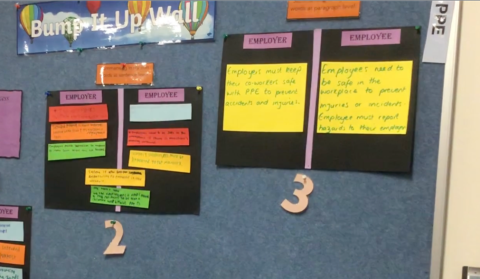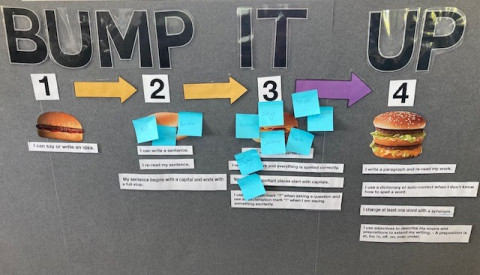Published 25 Aug 2023
Teacher innovation led by student feedback - Warringa Park School
Engaged with colleagues, school and the broader community
Kimberley Zammit - Acting Assistant Principal
Warringa Park School
Schools and early childhood services across Victoria continue to provide quality learning experiences across all levels. The VIT’s Professional Practice team is privileged to see this work first-hand on visits to workplaces around the state. Here is just one example spotlighting the great work happening in a Victorian school.
Kimberley Zammit is the Acting Assistant Principal at Warringa Park School. The school supports students aged 5-18 who have a diagnosed intellectual disability across four campuses.
Providing excellence in education for students with additional learning needs and post-school opportunities are key focus areas for the teaching staff at Warringa Park.
After a student voice survey in 2019 indicated senior students were feeling disengaged, the school embarked on a transformative journey to reconnect their learners with the curriculum and introduce new evidence-based teaching strategies to improve learning outcomes.
We spoke to Kimberley about the impact this process had on teaching staff and learners in their school community.
Q: Can you give some background to the development of your approach to the initiative including any research or established models / strategies that your approach is based upon?
In 2019, our Year 11/12 student voice survey data indicated a decrease in student voice and agency, intellectual engagement and a decline in student-teacher relationships and connectedness to school.
In analysing student educational outcomes and considering the results of our student voice survey, it became clear that significant changes were needed.
Teacher mentoring and learning walk observations further identified gaps in curriculum knowledge and evidence-based teaching approaches. A lack of rigour in the curriculum was evident. Teaching practices needed to be reimaged to reach students who were disengaged and further support post-school career opportunities.
In collaboration with the Later Years Learning Specialist, we pioneered a VCAL curriculum review, which led to a four-year action plan. A huge focus of this work has been on building a positive climate for learning by establishing individual student VCAL programs in collaboration with the careers teacher, classroom teacher, students, families and registered training organisations (RTOs) to ensure student voice and agency as well as realistic post-school opportunities are embedded into the school’s later years curriculum.
Our team worked meticulously over the year to support new and existing teachers to use evidence-based practices to teach the VCAL curriculum and implement the pedagogical approach of project-based learning into VCAL to provide students with voice and agency over their individual learning. Students were encouraged to demonstrate school pride, with the driving question: “How can you improve your school experience?”
This collaboration has achieved exemplary results in our school’s student voice survey. The 2020 data showed that
- students that wanted to learn at school rose by 46%
- students who felt that their teachers delivered engaging and purposeful lessons rose by 41%
- students who felt that staff at our school help them to learn increased by 41%
- students who agree that staff at school encourage them to say what they think rose by 43%
- students agreement that teachers at school ensure they have lots of opportunities to collaborate increased by 32%.
To further support inclusive education and post-school opportunities at Warringa Park School, we have built partnerships with RTOs and mainstream schools to provide opportunities for our students to participate in mainstream VET courses and learn alongside mainstream students. Supported VET programs were also implemented to provide learning for students with additional needs in mainstream, equal learning environments.
Q: What structural things are in place to ensure that the initiative has its best chance of success?
Our school has put in place weekly time for PLCs to meet and the weekly PLC leader meetings ensure that we are working consistently across teams. The weekly PLC meetings provide a set time for teachers to reflect on their practice and to engage in research.
We also have recently established a 3-year partnership with Real Schools, a teacher mentoring and coaching organisation, to drive restorative practices in our school.
Our leadership team strives to ensure quality is the top priority, and that we’re learning alongside our colleagues to promote growth in student development. Bringing that vision to life inspires and influences our team’s performance and pedagogy across our school community.
Q: What are the greatest benefits to staff development of this approach?
Staff have improved their data literacy and ability to identify more specific student learning needs through consideration of Renaissance Star Reading data, reading observational checklist data and student work samples. Through analysis of this data, students’ ability to use comprehension strategies (particularly summarising texts) was identified as an area of need.
Teachers used the High Impact Teaching Strategies to reflect on their practice and determined that explicit teaching and worked examples was an area that would benefit from further development, and that could be used to impact on students’ comprehension abilities.
To deepen their understanding of explicit teaching strategies, teams engaged with Ellen Levey’s research on the Gradual Release of Responsibility and John Hattie's Visible Learning research on micro-teaching.
Teachers filmed their classroom practice as they focused on implementing explicit teaching and worked examples. Teams then used the videos to evaluate their practice, using the research to guide their reflections on their strengths and areas for growth.
I modelled several strategies that teachers could use to make their teaching of comprehension strategies more explicit. I demonstrated the use of Jennifer Serravallo’s' reading strategies ‘Go with the Flow' and 'Take your Time' as an example of making thinking visible and providing a model that is accessible and inclusive for a range of abilities.
I also modelled using a bump-it-up wall. This strategy provided students with a visual display of work samples at different levels, providing them with an explicit example of how to improve their summarising.
After observing, teachers willingly trialled these strategies and reported having a more practical understanding of what explicit teaching can look like.

Bump-it-up-wall at Warringa Park School

Bump-it-up wall at Waringa Park School
Q: What have been the benefits to learner outcomes of this approach? Please provide some illustrative examples if appropriate.
Focusing on explicit teaching and worked examples lead to significant improvements in students’ comprehension skills as evidenced through the Renaissance Star Reading data.
The data indicated that students in Year 11 and 12 made an average of one full year's growth in their reading ages in only two terms.
The bump-it-up wall was also integral in supporting students to have agency and identify the next steps in their learning. As the walls were co-constructed with students over a series of lessons, students had ownership and a greater depth of understanding, particularly when compared to previous classroom displays that had been put together without student contributions. Students were observed interacting with the wall, reflecting on their work, and using the criteria to consider how they could improve.
Q: What plans does your workplace have to take this approach forward?
Student voice surveys have now been implemented across all our Later Years campuses and we have seen a steady increase in positive feedback from students over the past three years.
Bump it-up walls are now in all classrooms to support the HIT strategy of feedback, metacognition and student reflection.
Our partnership with Real Schools continues our work on student voice and agency and restorative practices. This has been added into our action plan as we work through the Senior Secondary Reform and continue to build the practice and curriculum understanding of our teachers. We have further partnered with a number of Special Schools and meet monthly to discuss the opportunities of building a cluster to provide VET opportunities for our students across this network.
Q: Can you detail any references or citations applicable?
- Learning Walks – Australian Institute for Teaching and School Leadership (AITSL)
- High Impact Teaching Strategies (HITS) – Victorian State Government, Department of Education
- Gradual Release of Responsibility – Ellen Levey
- John Hattie and micro-teaching – Rosie Neill, Iris Connect
- The Reading Strategies Book 2.0, Your Research-Based Guide to Developing Skilled Readers – Jennifer Serravallo
- Renaissance Star Reading – Renaissance
- What is a bump-it-up wall and why should you use it? – Victorian State Government Education and Training.
Do you have an example of outstanding work in your school or early childhood service? We’d like to consider showcasing it the Excellence in Teaching section of our website. Send your example and contact details to vitcomms@vit.vic.edu.au
